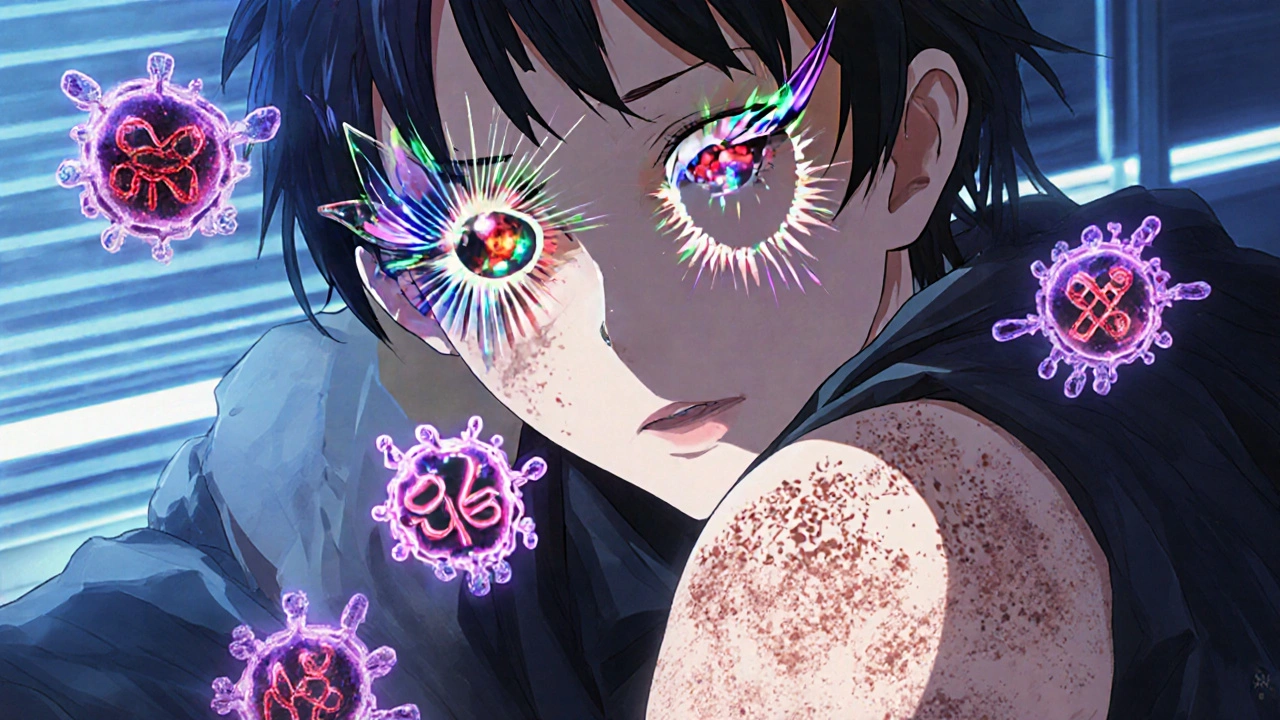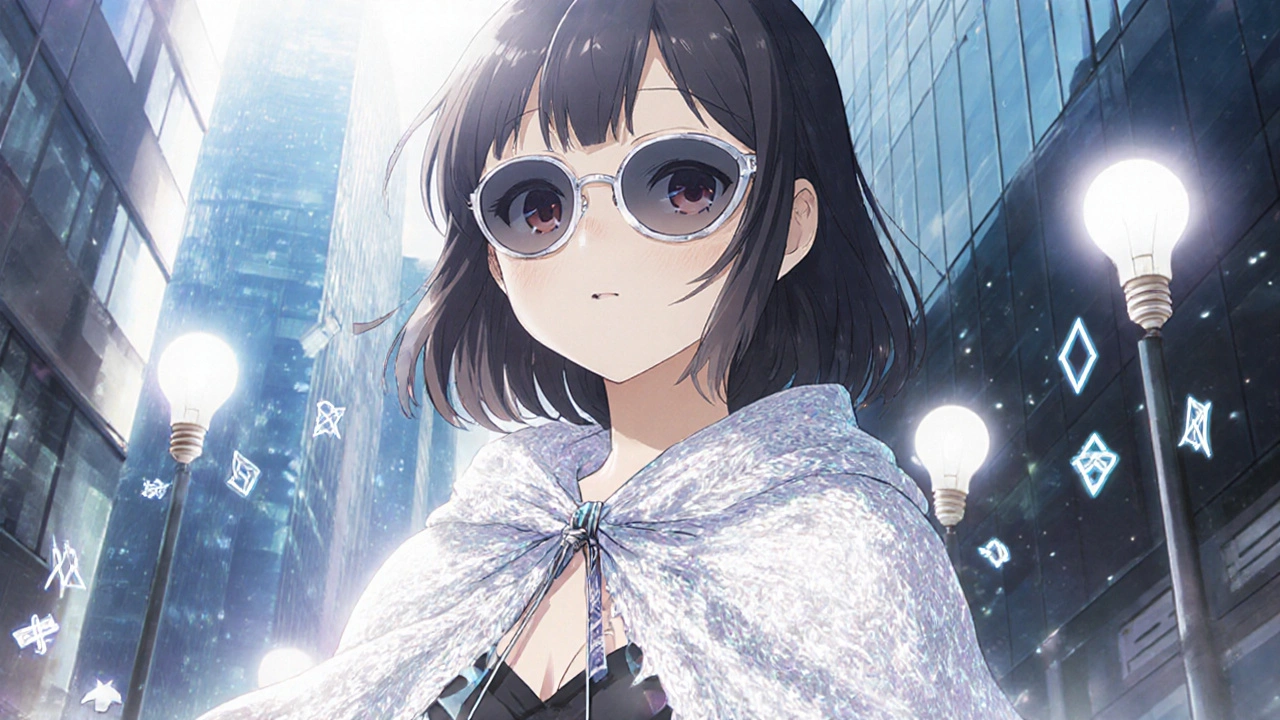When you have cutaneous lupus, the sun isn’t just uncomfortable-it can trigger a full-blown flare. A simple walk outside, sitting near a window, or even working under fluorescent lights can cause a red, scaly rash to appear on your face, arms, or neck. For many, this isn’t just a cosmetic issue-it’s a sign that the immune system is attacking the skin, and sometimes, the whole body. About 50-75% of people with lupus experience this extreme sensitivity to ultraviolet (UV) light, and for a large portion, it’s the main reason their symptoms get worse.
Why Sunlight Makes Cutaneous Lupus Worse
It’s not just a bad sunburn. In cutaneous lupus, UV rays-both UVA and UVB-set off a chain reaction inside the skin. When sunlight hits the skin of someone with lupus, skin cells (keratinocytes) start dying off at a much faster rate than normal. Studies show this happens 2.3 times more in lupus patients than in people without the disease. These dying cells release proteins that the immune system mistakes for invaders. That triggers inflammation, and soon, you see a rash. One key player in this process is interferon-kappa (IFN-κ), a signaling protein made by skin cells. In lupus, UV exposure causes IFN-κ levels to spike by 400-600%. This protein then calls in other immune cells, turning the skin into a war zone. Chemicals like CCL5 and CCL8 surge by 300%, pulling in more immune cells that worsen redness, swelling, and scaling. The timing matters too. Most people don’t see a rash right away. Symptoms usually show up 24 to 72 hours after exposure and can last anywhere from 3 to 21 days. If a rash lasts longer than three weeks, there’s an 89% chance it’s true lupus-related photosensitivity-not just a harmless condition like polymorphous light eruption (PMLE).What the Rash Looks Like-And Where It Shows Up
Cutaneous lupus isn’t one single condition. It’s a group of skin disorders, each with its own pattern of rashes-and each triggered differently by sunlight.- Acute cutaneous lupus (ACLE) shows up as the classic "butterfly rash"-a red, flat or slightly raised patch across the cheeks and nose. It appears in 85% of cases after sun exposure and often fades without scarring. But it’s a red flag: if you get this rash, there’s a high chance your lupus is active elsewhere in the body.
- Subacute cutaneous lupus (SCLE) causes ring-shaped or scaly patches that look like psoriasis. These appear on the chest, back, and arms, and are 92% linked to UV exposure. Unlike ACLE, SCLE rarely scars, but it can be stubborn and hard to treat.
- Chronic cutaneous lupus (CCLE), or discoid lupus, is the most damaging. It creates thick, red, scaly plaques that scar and change skin color. Sunlight doesn’t usually cause new lesions here-but it makes existing ones worse. About 76% of people with discoid lupus see their lesions flare after UV exposure.
Hidden Triggers: It’s Not Just the Sun
Many people think avoiding the sun is enough. But UV light comes from other places too. Fluorescent lights-especially older CFL bulbs-emit UVA radiation. In surveys, 74% of lupus patients on Reddit and LupusConnect say these lights trigger rashes or fatigue. One patient wrote: "I got a full butterfly rash after 15 minutes sitting by a window at work." Glass blocks UVB but not UVA, so even indoors, you’re not safe. Even LED lights are not always safe. Some cheaper LEDs still leak small amounts of UV. The fix? Replace fluorescent and halogen bulbs with high-quality LEDs labeled "UV-free." Studies show this cuts UV exposure by 92%.
What Actually Works: Skin-Targeted Treatments
The good news? You don’t have to live in the dark. There are effective, targeted treatments that work directly on the skin.- Topical steroids (like hydrocortisone or clobetasol) are first-line for mild to moderate rashes. They reduce inflammation fast but shouldn’t be used long-term on the face due to skin thinning.
- Calcineurin inhibitors like tacrolimus (Protopic) and pimecrolimus (Elidel) are steroid-free options. They’re especially useful for sensitive areas like the eyelids or lips. Studies show they reduce redness and scaling in 70% of SCLE and CCLE patients after 8 weeks.
- Topical retinoids (tretinoin) help with discoid lesions by normalizing skin cell growth. They’re slow but effective for long-term management.
- Antimalarials like hydroxychloroquine (Plaquenil) are the backbone of treatment. They don’t just treat the skin-they reduce flares system-wide. About 60% of patients see significant improvement in rashes within 3 months. It’s not a cream-it’s a pill-but it works directly on skin inflammation.
Photoprotection: Your Daily Shield
No treatment works if you keep exposing your skin to UV light. The key is consistent, smart protection.- Sunscreen: Use SPF 50+ with zinc oxide or titanium dioxide. These are physical blockers-they sit on top of the skin and reflect UV. Chemical sunscreens can irritate lupus skin. Reapply every 2 hours, even on cloudy days. When used correctly, sunscreen prevents 87% of skin flares.
- Clothing: Wear UPF 50+ fabric. Regular cotton blocks only 20-30% of UV. UPF 50+ blocks 98%. Look for long sleeves, wide-brimmed hats, and UV-blocking gloves.
- Window film: Install UV-blocking film on home and car windows. It cuts UVA transmission by 99.9%. Many companies, including Microsoft and Johnson & Johnson, now use this in their offices for employees with lupus.
- Eyewear: If you get photophobia (light sensitivity in the eyes), FL-41 tinted glasses reduce symptoms by 68%. They’re not sunglasses-they’re specialized lenses that filter out the exact wavelengths that trigger lupus flares.
What Doesn’t Work-and What to Avoid
Many people try natural remedies or "gentle" sunscreens. But not all products are safe.- Avoid sunscreens with oxybenzone, avobenzone, or fragrances. These can irritate lupus skin or even trigger allergic reactions.
- Don’t rely on "natural" mineral sunscreens that aren’t labeled SPF 50+. Some only offer SPF 15 or 20-far too low.
- Don’t wait until you’re burned to act. By then, the damage is done. Prevention is the only reliable strategy.

Real-Life Challenges
Getting proper care isn’t always easy. In a 2022 survey by the Lupus Foundation of America, 58% of patients said their primary doctor dismissed their photosensitivity as "just being sensitive to the sun." That delay can cost months-or years-of unnecessary flares. And it’s not just medical. Workplace accommodations are still rare. Even though companies like Microsoft have installed UV-filtering films in their offices, most employers don’t know what to do. If you’re struggling, ask for: LED lighting, window film, flexible hours to avoid midday sun, or remote work options.What’s Next in Research
Scientists are working on smarter tools. New wearable devices-still in testing-can track your UV exposure in real time and alert you when you’re at risk of a flare. Early models are 92% accurate at predicting when a reaction is coming. The future of treatment is personalization. Blood tests for Ro/SSA antibodies can now identify who’s most at risk: patients with these antibodies have a 78% chance of severe photosensitivity, compared to just 42% without them. That means doctors can tailor protection plans before the first rash appears.Bottom Line: Control the Light, Control the Disease
Cutaneous lupus is manageable-but only if you treat UV exposure like a medical threat, not an inconvenience. The evidence is clear: rigorous photoprotection prevents up to 70% of skin flares. Combine that with targeted treatments like antimalarials and topical anti-inflammatories, and you can live a full, active life without hiding from the sun. It’s not about fear. It’s about strategy. Know your triggers. Protect your skin. Use the right treatments. And don’t let anyone tell you it’s "just a rash." Your skin is your body’s first line of defense-and it’s telling you something important.Is cutaneous lupus the same as systemic lupus?
No. Cutaneous lupus mainly affects the skin, while systemic lupus (SLE) can damage organs like the kidneys, heart, and lungs. But the two are linked. About half of people with cutaneous lupus eventually develop systemic symptoms. A skin rash, especially the butterfly rash, can be the first sign of SLE. That’s why skin flares shouldn’t be ignored.
Can I get enough vitamin D if I avoid the sun?
Yes. Sun avoidance doesn’t mean vitamin D deficiency. Most people with lupus get vitamin D through supplements. Doctors typically recommend 1,000-2,000 IU daily, especially if blood tests show low levels. Some antimalarials like hydroxychloroquine can lower vitamin D, so regular testing is important.
Do all sunscreens work for lupus?
No. Avoid chemical sunscreens with oxybenzone, octinoxate, or fragrances-they can irritate lupus skin. Stick to mineral sunscreens with zinc oxide or titanium dioxide as the only active ingredients. Look for "broad spectrum," SPF 50+, and "non-comedogenic." Test a small patch first.
Why do my rashes come back even when I use sunscreen?
Sunscreen alone isn’t always enough. UVA rays penetrate glass and clouds, and many people don’t reapply often enough. You also need UPF 50+ clothing, wide-brimmed hats, UV-blocking window film, and avoiding midday sun. Combine all these for best results. Also, make sure your sunscreen isn’t expired-active ingredients lose potency after one year.
Can I use tanning beds if I have cutaneous lupus?
Absolutely not. Tanning beds emit intense UVA and UVB radiation-far stronger than sunlight. Even one session can trigger a severe flare that lasts weeks. There is no safe level of artificial UV for people with cutaneous lupus. Dermatologists universally warn against it.
How long does it take for skin treatments to work?
Topical steroids and calcineurin inhibitors often improve rashes in 1-2 weeks. Antimalarials like hydroxychloroquine take longer-typically 3 to 6 months for full effect. Don’t stop them just because you don’t see immediate results. They work to prevent flares over time. For new drugs like anifrolumab, skin improvements are usually seen within 12-16 weeks.
Should I see a dermatologist or a rheumatologist for cutaneous lupus?
Both. A dermatologist can diagnose and treat the skin lesions. A rheumatologist manages the overall disease and checks for systemic involvement. Many patients benefit from a team approach. If your dermatologist doesn’t know much about lupus, ask for a referral to a specialist in autoimmune skin diseases.


Denny Sucipto
November 18, 2025 AT 16:26Man, I wish I’d known all this when I first got diagnosed. I used to think sunscreen was just for beach days. Now I’ve got UPF shirts, UV window film on my car, and I refuse to sit near fluorescent lights at work. My rash hasn’t flared in 8 months. It’s not about being paranoid-it’s about surviving.
Shilpi Tiwari
November 20, 2025 AT 14:16Interesting breakdown of IFN-κ upregulation post-UVA exposure-though I’d argue the 400-600% spike is context-dependent on keratinocyte subtype heterogeneity. The CCL5/CCL8 chemokine axis is more reliably elevated in SCLE than CCLE, per the 2021 JID meta-analysis. Also, hydroxychloroquine’s mechanism isn’t just anti-inflammatory-it modulates TLR7/9 signaling in endosomes. If you’re not testing Ro/SSA titers, you’re missing the biomarker stratification key.
Kristina Williams
November 21, 2025 AT 03:59They’re lying about the lights. Fluorescent bulbs don’t cause flares-it’s the 5G towers and smart meters they’ve hidden in your office ceiling. I saw a guy on YouTube who used an EMF meter and his rash dropped after he removed his smart fridge. The FDA doesn’t want you to know this. Also, vitamin D supplements are fake-they’re just filling you with poison to keep you dependent on meds.
Christine Eslinger
November 22, 2025 AT 07:41Thank you for writing this with so much clarity. I’ve been living with discoid lupus for 12 years, and no one ever explained why my eyelids kept cracking open like paper. Tacrolimus saved my face. I used to cry every morning because I couldn’t wear makeup without it burning. Now I go hiking, I travel, I live. It’s not perfect-but it’s possible. Don’t let anyone make you feel like your skin is a flaw. It’s a map of your strength.
Louie Amour
November 22, 2025 AT 17:33Wow, another ‘lupus warrior’ sob story. You people treat SPF 50 like it’s holy water. Newsflash: 90% of you are just lazy and don’t want to wear a hat. I’ve had lupus for 15 years. I go outside in shorts and t-shirts. I use chemical sunscreen. I don’t cry about it. Stop acting like your skin is a sacred temple. It’s just tissue. Get over it.
Hal Nicholas
November 24, 2025 AT 03:46So you’re telling me I can’t sit by a window? I work from home. My whole life is indoors. And now you want me to buy UV-blocking film, special glasses, UPF clothing, and replace every bulb in my house? That’s not a treatment plan-that’s a cult initiation. I’m not paying $200 for a hat that says ‘I have lupus’ on it. Just give me a pill and shut up.
Holly Powell
November 26, 2025 AT 00:41Let’s be real: the entire ‘photoprotection gospel’ is a pharmaceutical marketing ploy. Hydroxychloroquine is cheap. Anifrolumab costs $50k/year. The real reason they push ‘UV = enemy’ is to keep you dependent on expensive biologics. Also, ‘UPF 50+’ is a meaningless label-there’s zero independent regulation. You’re being manipulated by fear-based dermatology.
Emanuel Jalba
November 26, 2025 AT 05:17😭 I just got diagnosed last week and I’m already crying. I thought I was just allergic to the sun. Now I’m scared to leave my house. But I’m gonna try the zinc oxide and the FL-41 glasses. I’m not giving up. 🙏✨ #LupusWarrior #SunIsTheEnemy #IWillSurvive